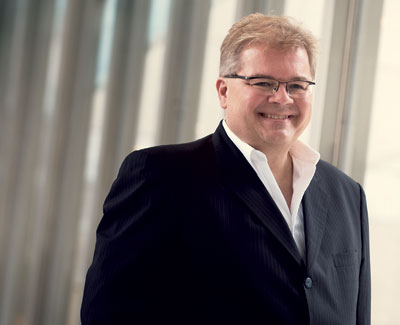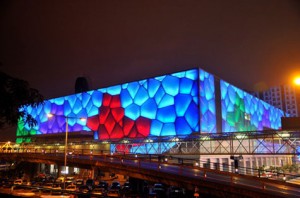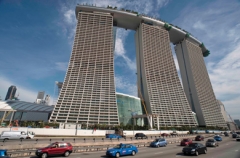 Before he got elbowed aside in favor of ‘starchitects,’ Paul Steelman was one of the go-to designers on the Las Vegas Strip. He’s also one of the very few people who can say they’ve worked — without repercussion — for both Stanley Ho and Sheldon Adelson. Steelman’s low-cost repurposing of a Macao department store into Stanley Ho’s revised Oceanus (after the jump) earned a number of headlines, particularly for its “water cube” look.
Before he got elbowed aside in favor of ‘starchitects,’ Paul Steelman was one of the go-to designers on the Las Vegas Strip. He’s also one of the very few people who can say they’ve worked — without repercussion — for both Stanley Ho and Sheldon Adelson. Steelman’s low-cost repurposing of a Macao department store into Stanley Ho’s revised Oceanus (after the jump) earned a number of headlines, particularly for its “water cube” look.
Well, Steelman has been to the mountain (or rather, the Pacific Rim) and returned to Las Vegas with a few lessons to bestow. He dispensed his Rx for the casino industry while picking up his Jay Sarno Award on the opening day of Global Gaming Expo. The gist of his message is that casino-hotels have gotten simply too big for their own financial good and are trying to be too many things to too many people. One instance he cited was the ROI per square foot at The Mirage, which has been more than 50% better than that of Venetian Macao, on the doorstep of gambling-mad China.
Part of the problem, as Steelman sees it, is too much square footage that doesn’t generate significant revenue. He cites a herd-mentality conceptual process for megaresorts that entails throwing everything imaginable into the blender. (How else did we wind up with so many dud condo-hotels?) For instance, after one Strip resort had a successful brew pub, eight of its competitors came to Steelman wanting him to design the same sort of amenity for them. He compares the old business model in which the casino was the profit center to today’s state of affairs, in which the casino is but one of several equivalent and rival profit hubs.
 That may be the natural evolution of Vegas resorts but not every developer can afford to play in that ballpark, and the correlative to bigger and bigger megaresorts has been diminished return on investment. We’re long past the point when a Vegas Strip casino could pay for itself in five years. Steelman decries the prevalence of high-end nightclubs, which he sees as sucking money out of the casino, and of pool parties, both of which he blames for the Hard Rock Hotel & Casino‘s financial collapse. (One could cite several other factors but let’s give Steelman the floor.)
That may be the natural evolution of Vegas resorts but not every developer can afford to play in that ballpark, and the correlative to bigger and bigger megaresorts has been diminished return on investment. We’re long past the point when a Vegas Strip casino could pay for itself in five years. Steelman decries the prevalence of high-end nightclubs, which he sees as sucking money out of the casino, and of pool parties, both of which he blames for the Hard Rock Hotel & Casino‘s financial collapse. (One could cite several other factors but let’s give Steelman the floor.)
With limited exceptions, the veteran architect points to the smaller, simpler casinos of Macao as the way of the future. This presupposes that the tastes of Macanese gamblers = Las Vegas gamblers. Steve Wynn and Sheldon Adelson have already learned the hard way that the reverse equation doesn’t hold true. Similarly, his query as to why casino companies aren’t developing their own unique slot machines focused only how cheap it would be to build them in China, ignoring the substantial costs of R&D — and of every slot game that fails to catch on with players. Casinos have shown no appetite for assuming that risk from the IGTs of the world.
However, if we’re not going to be waiting a decade for new hotel construction on the Strip, it’s probably time to think smaller. The industry certainly needs to drop the circular reason that argues, ‘Because I (over)paid a premium for this land I have to build an ultra-expensive resort to justify my real estate expenditure. ‘All that does is push the break-even point further down the road.
 Among other observations, Steelman declared self-conscious architecture (read: CityCenter) passé and “fantasy architecture” (i.e., Marina Bay Sands, left) the New Wave. He also argued that brighter casinos are ones that perform better, citing a 45% increase in gross win at Galaxy Star World after its interior illumination was improved. (Steelman needs to send that memo down the road to Aria.) He chided the industry for its lack of interest in “green” building, wondering why solar power and electric cars are still regarded as novel concepts, noting that the average power bill for a Strip casino — water and gas not included — averages $40 million a year. And, for those who retain fondness for the Sahara, Riviera and their ilk, he talked up the Macanese tradition of upgrading older casinos but retaining their vintage architecture.
Among other observations, Steelman declared self-conscious architecture (read: CityCenter) passé and “fantasy architecture” (i.e., Marina Bay Sands, left) the New Wave. He also argued that brighter casinos are ones that perform better, citing a 45% increase in gross win at Galaxy Star World after its interior illumination was improved. (Steelman needs to send that memo down the road to Aria.) He chided the industry for its lack of interest in “green” building, wondering why solar power and electric cars are still regarded as novel concepts, noting that the average power bill for a Strip casino — water and gas not included — averages $40 million a year. And, for those who retain fondness for the Sahara, Riviera and their ilk, he talked up the Macanese tradition of upgrading older casinos but retaining their vintage architecture.
The major exception Steelman made to his small-is-beautiful theme was the “integrated resort” concept that’s been so successful in Singapore. Of course, in order to work it presupposes very limited competition … imagine an Atlantic City with only Borgata and Bally’s Wild Wild West. It’s possible to propose counter-arguments to a number of Steelman’s arguments and tempting to write his remedies off as a blast from the derriere-garde. But in a casino industry that’s grown beyond its means, it’s worth pondering what Steelman had to say.


Fascinating comments by Steelman, especially on brightness in casinos and nightclubs & pool parties.
In 2004 through 2008 Las Vegas, Dubai and China were building huge projects and the costs of these projects were extremely high because the cost of raw materials (cement, steel, etc.) kept going up and up and up. Dubai has a tower called the Burj Khalifa that is around 2700 feet high or so which is the tallest in the world. Now with not many projects being built throughout the world because of a lousy economy the cost of raw materials has dropped a lot so hopefully some more reasonably priced projects can be built.
Paul,
“Now with not many projects being built throughout the world because of a lousy economy the cost of raw materials has dropped a lot so hopefully some more reasonably priced projects can be built.”
– Unless they decide to use the savings to buy more material to build something even bigger!
I bet a moderate sized casino on the Strip with decent video poker pay tables would do well indeed. Sometime one of these places will open with a theme of…gambling!
It seems that casinos are forgetting their main purpose,”GABMBLING”! I really like his idea of keeping some of the old flavor. For example the former Barbary Coast now Bill’s,Flamingo, Harrahs. Simplify!
Sid